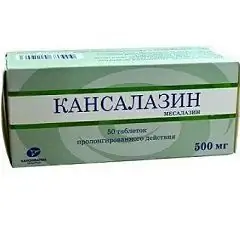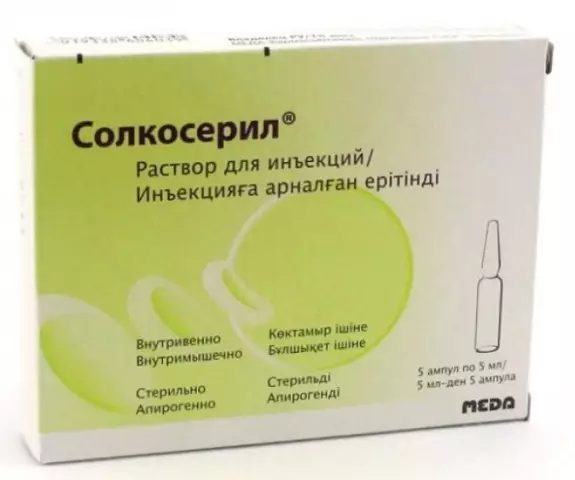- Author Rachel Wainwright [email protected].
- Public 2023-12-15 07:39.
- Last modified 2025-11-02 20:14.
Kansalazin
Kansalazin: instructions for use and reviews
- 1. Release form and composition
- 2. Pharmacological properties
- 3. Indications for use
- 4. Contraindications
- 5. Method of application and dosage
- 6. Side effects
- 7. Overdose
- 8. Special instructions
- 9. Application during pregnancy and lactation
- 10. Use in childhood
- 11. In case of impaired renal function
- 12. For violations of liver function
- 13. Drug interactions
- 14. Analogs
- 15. Terms and conditions of storage
- 16. Terms of dispensing from pharmacies
- 17. Reviews
- 18. Price in pharmacies
Latin name: Kansalazin
ATX code: A07EC02
Active ingredient: mesalazine (Mesalazine)
Manufacturer: prolonged-release tablets - CJSC "Kanonfarma production" (Russia); rectal suppositories - Altpharm LLC (Russia)
Description and photo update: 2019-05-07
Prices in pharmacies: from 600 rubles.
Buy

Kansalazin is an anti-inflammatory and antibacterial drug used to treat ulcerative colitis and Crohn's disease.
Release form and composition
- prolonged-release tablets: biconvex, round, white with a gray tinge or almost white, slight inclusions are possible (10 or 15 pieces in a blister strip, in a cardboard box 1, 3, 5, 6, 9 or 10 packs of 10 each. or 2, 4 or 6 packs of 15 pcs.);
- rectal suppositories: torpedo-shaped, from pale gray to almost white, with a possible pale pink tint (5 pcs. in a blister strip, in a cardboard box 2 or 6 packs).
Each pack also contains instructions for the use of Kansalazin.
1 prolonged-release tablet contains:
- active substance: mesalazine - 500 mg;
- additional components: colloidal silicon dioxide, calcium hydrogen phosphate dihydrate, sodium alginate, copovidone, magnesium stearate, microcrystalline cellulose.
1 rectal suppository contains:
- active substance: mesalazine - 500 mg;
- additional components: sodium docusate, Witepsol N-15 solid fat, cetyl alcohol.
Pharmacological properties
Pharmacodynamics
Mesalazine, the active ingredient in Kansalazin, has an anti-inflammatory effect. Suppresses the production of metabolites of arachidonic acid - leukotrienes and prostaglandins, inhibits the activity of neutrophilic lipoxygenase, prevents leukocyte chemotaxis. The substance helps to slow down the migration, degranulation and phagocytosis of neutrophils, as well as the production of immunoglobulins by lymphocytes. Kansalazin demonstrates an antibacterial effect against some cocci and Escherichia coli (manifested in the colon).
Mesalazine exhibits antioxidant properties by binding to free oxygen radicals and destroying them. The effect of the drug after oral administration or rectal administration is predominantly due to the local effect on contact with the inflamed intestinal tissue.
Kansalazin is well tolerated. The drug in the form of prolonged-release tablets reduces the risk of relapse in Crohn's disease, especially in patients with ileitis and with a long duration of the disease.
Pharmacokinetics
Approximately 30-50% of an oral dose of mesalazine is absorbed mostly in the small intestine. When administered rectally, the release of the active substance occurs in the colon and rectum. Metabolic transformation occurs in the intestinal mucosa and in the liver by acetylation and to a small extent with the help of enterobacteria with the formation of the main metabolite, N-acetyl-5-aminosalicylic acid. As a consequence, the plasma level of the drug is relatively low. Mesalazine binds to plasma proteins by 43%, and its main metabolite by 73-83%.
Mesalazine, as well as its metabolites, does not pass through the blood-brain barrier, however, it penetrates in the form of a metabolite into breast milk (0.1% of the dose). After oral administration of Kansalazin in a daily dose of 1500 mg, cumulative properties were revealed in healthy volunteers. The agent accumulates against the background of chronic renal failure (CRF). Mesalazine and its metabolites are excreted from the body by the kidneys and intestines.
Indications for use
Kansalazin extended-release tablets are recommended for the prevention and treatment of exacerbations of ulcerative colitis and Crohn's disease.
Rectal suppositories Kansalazin are intended for the treatment of ulcerative colitis (distal colon) in the exacerbation phase, as well as as maintenance therapy during remission.
Contraindications
Absolute:
- peptic ulcer of the stomach and duodenum (in the period of exacerbation - for suppositories);
- severe violations of the liver and / or kidneys;
- hemorrhagic diathesis (with a predisposition to bleeding - for suppositories);
- blood diseases - for pills;
- age up to 18 years - for suppositories; age up to 12 years, as well as body weight less than 50 kg - for tablets;
- lactation period - for tablets;
- last 2-4 weeks of pregnancy - for tablets;
- hypersensitivity to any of the constituents of the drug and other derivatives of salicylic acid.
Relative (Kansalazin should be treated with caution):
- deficiency of glucose-6-phosphate dehydrogenase;
- impaired liver and / or kidney function;
- I trimester of pregnancy - for pills;
- respiratory dysfunction (especially the presence of bronchial asthma) - for suppositories.
Kansalazin, instructions for use: method and dosage
Extended-release tablets
Kansalazin tablets are taken orally after meals, without breaking or chewing, swallowing whole and drinking plenty of liquid. The daily dose of the drug is selected individually and divided into several doses.
Recommended daily doses of Kansalazin, depending on the indications and age of the patients:
- ulcerative colitis (exacerbation period), Crohn's disease (exacerbation stage and supportive treatment): adults - up to 4000 mg (up to 8 tablets), adolescents over 12 years of age with a body weight of at least 50 kg - 20-30 mg / kg;
- ulcerative colitis (maintenance therapy): adults - 2000 mg (4 tablets), adolescents over 12 years of age with a body weight of at least 50 kg - 20-30 mg / kg.
Rectal suppositories
Kansalazin suppositories are administered rectally (into the rectum) after bowel movement. For the treatment of ulcerative colitis in the acute phase, the drug is administered 3 times a day, 500 mg (1 suppository), the daily dose is 1500 mg (3 suppositories).
Side effects
Extended-release tablets
- cardiovascular system: chest pain, palpitations, shortness of breath, increase / decrease in blood pressure (BP), tachycardia;
- digestive system: decreased appetite, nausea, heartburn, vomiting, abdominal pain, diarrhea, increased activity of hepatic transaminases, pancreatitis, hepatitis;
- nervous system: dizziness, tinnitus, headache, tremor, polyneuropathy, depression;
- urinary system: anuria, proteinuria, crystalluria, oliguria, hematuria, nephrotic syndrome;
- hematopoietic organs: hypoprothrombinemia, anemia (megaloblastic, aplastic, hemolytic), leukopenia, thrombocytopenia, agranulocytosis;
- allergic reactions: itching, skin rash, dermatoses, bronchospasm;
- others: weakness, decreased production of tear fluid, lupus-like syndrome, photosensitivity, alopecia, parotitis, oligospermia.
Rectal suppositories
- blood and lymphatic system: extremely rare (<0.01%, including isolated cases) - pathological blood parameters (aplastic anemia, leukopenia, neutropenia, agranulocytosis, thrombocytopenia, pancytopenia);
- nervous system: rarely (> 0.01% and <0.1%) - dizziness, headache; extremely rare - peripheral neuropathy;
- cardiovascular system: rarely - myocarditis, pericarditis;
- respiratory organs: extremely rarely - allergic and fibrotic reactions from the lungs (shortness of breath, cough, alveolitis, pulmonary eosinophilia, infiltration in the lungs, pneumonitis, bronchospasm);
- digestive system: rarely - abdominal pain, nausea, vomiting, diarrhea, bloating; extremely rarely - acute pancreatitis, changes in liver function (increased cholestasis parameters and transaminase activity), cholestatic hepatitis;
- urinary system: extremely rarely - impaired renal function, including interstitial nephritis, renal failure;
- skin and subcutaneous tissue: extremely rare - alopecia;
- musculoskeletal system: extremely rare - myalgia, arthralgia;
- immune system: extremely rarely - hypersensitivity reactions [eg, allergic exanthema, drug fever, lupus erythematosus syndrome (SLE), pancolitis];
- reproductive system: extremely rare - oligospermia (reversible).
Overdose
Extended-release tablets
With a single dose of less than 150 mg / kg, an overdose of mild severity is observed, 150-300 mg / kg - moderate, more than 300 mg / kg - severe.
Signs of an overdose of Kansalazin of mild and moderate severity may include symptoms of salicylism: general malaise, dizziness, tinnitus, severe headache, blurred vision, nausea, vomiting, fever (a poor prognostic sign in adults). Against the background of severe intoxication, the following symptoms may appear: drowsiness, anuria, convulsions, bleeding, confusion, collapse, hyperventilation of the lungs of central origin, respiratory alkalosis, metabolic acidosis. Initially, central hyperventilation of the lungs causes the development of respiratory alkalosis, manifested in the form of cold sticky sweat, shortness of breath, suffocation, cyanosis; with increased intoxication, respiratory paralysis and uncoupling of oxidative phosphorylation are aggravated, which leads to respiratory acidosis.
In the case of chronic overdose, the level of mesalazine detected in the plasma correlates poorly with the severity of intoxication. The threat of chronic intoxication is aggravated in elderly patients while taking Kansalazin for several days at a daily dose of more than 100 mg / kg. In the elderly and children, the initial symptoms of salicylism do not always appear, therefore it is recommended to periodically determine the content of salicylates in the blood. In moderate / severe poisoning, the level of salicylates is more than 70 mg%, in extremely severe, prognostically unfavorable - more than 100 mg%. If a moderate intoxication is established, the patient needs hospitalization for 24 hours. In this condition, vomiting is provoked, activated charcoal and laxatives are prescribed,carry out constant monitoring of the acid-base composition of the blood (CBS) and electrolyte balance. Sodium bicarbonate, sodium citrate or sodium lactate solution are introduced, depending on the state of metabolism.
An increase in reserve alkalinity leads to an increase in the elimination of mesalazine as a result of alkalinization of urine. With a salicylate content of more than 40 mg%, a decrease in urine acidity is shown by alkalization, carried out with an intravenous infusion of sodium bicarbonate - 88 mEq in 1 liter of 5% dextrose solution at a rate of 10-15 ml / h / kg. In order to restore the volume of circulating blood (BCC) and induce diuresis in the same doses and dilution, sodium bicarbonate is administered 2-3 times. In elderly patients, caution is required, as they may experience pulmonary edema by intensive fluid infusion. It is not recommended to use acetazolamide to alkalize urine, since it can cause acidemia and aggravate the toxic effects of salicylates.
Hemodialysis is recommended when the level of salicylates is over 100-130 mg%, and against the background of chronic poisoning - 40 mg% or less, in the presence of such indications as progressive deterioration of the condition, refractory acidosis, severe damage to the central nervous system, renal failure and edema lungs. If pulmonary edema develops, artificial ventilation of the lungs (IVL) is prescribed with an oxygen-enriched mixture.
Rectal suppositories
Cases of overdose of Kansalazin in the form of rectal suppositories are rare. In this condition, there are no symptoms of nephrotoxicity / hepatotoxicity, but there may be signs of salicylate poisoning (nausea, weakness, vomiting, drowsiness, pulmonary edema, hyperventilation). There is no specific antidote, symptomatic and supportive therapy is performed.
special instructions
Before the start of the course, during treatment with Kansalazin and after its cancellation, it is advisable to carry out a general blood test and urine analysis, to monitor the excretory function of the kidneys and indicators of the functional state of the liver - the activity of alanine aminotransferase (ALT) and aspartate aminotransferase (ACT), as well as the plasma level of creatinine in the blood. Control examinations are recommended, as a rule, to be carried out 14 days after the initiation of therapy and then 2-3 times with an interval of 4 weeks. If the test results are within the normal range, then the survey data can be performed every 3 months. If additional symptoms develop, follow-up tests are urgently needed.
In patients belonging to slow acetylators, the risk of adverse reactions is aggravated; urine and tears may become yellow-orange, stained with soft contact lenses.
It is not recommended to use rectal suppositories in patients with functional impairment of the kidneys. If, during therapy, deterioration of renal activity is detected, the possible nephrotoxic effect of mesalazine should be taken into account.
Patients with impaired lung function (especially those suffering from bronchial asthma) when using suppositories need careful monitoring.
Persons with established hypersensitivity to drugs containing sulfasalazine can start Kansalazine therapy only under strict medical supervision. In case of signs of acute intolerance, which may include acute pain and cramps in the abdomen, severe headaches, fever and skin rashes, the use of the drug should be stopped immediately.
If the patient misses the next dose of pills, the missed dose must be taken at any time or together with the next dose. If several doses are missed, it is necessary to consult a specialist without stopping therapy.
Influence on the ability to drive vehicles and complex mechanisms
Patients driving vehicles or servicing other complex and moving mechanisms are advised to refrain from performing these types of activities during treatment with Kansalazin due to the possible occurrence of undesirable reactions (dizziness and others).
Application during pregnancy and lactation
It has been established that mesalazine penetrates the placental barrier, but since the experience of its use in pregnant women is limited, it is not possible to assess the risk of possible adverse events during drug treatment during pregnancy. In studies on animals in which the drug was used orally, no negative effects on pregnancy, embryo / fetal development and childbirth were found.
Therapy in pregnant women is possible only if the expected benefit to the mother significantly outweighs the possible threat to the health of the fetus. In the last 2-4 weeks of pregnancy, taking Kansalazin tablets is contraindicated.
Mesalazine is excreted in breast milk in significantly lower concentrations compared to those in a woman's blood plasma, however, acetyl-mesalazine (its main metabolite) is excreted in similar or higher concentrations. If it is necessary to use Kansalazin during lactation, it is required to stop breastfeeding.
Pediatric use
Kansalazin rectal suppositories are contraindicated for patients under the age of 18 years, prolonged-release tablets - for patients under 12 years of age, as well as those with a body weight of less than 50 kg.
With impaired renal function
In the presence of a severe degree of renal failure, the use of Kansalazin is contraindicated, in case of mild to moderate degree, it is recommended to use the drug with caution.
For violations of liver function
In the presence of severe hepatic impairment, the use of Kansalazin is contraindicated, with mild and moderate degrees, the drug should be used with caution.
Drug interactions
- sulfonylurea derivatives: their hypoglycemic effect is enhanced;
- sulfonamides, furosemide, rifampicin, spironolactone: their activity decreases;
- uricosuric drugs (tubular secretion blockers): their effectiveness increases;
- methotrexate: the risk of its toxic effects is aggravated;
- glucocorticosteroids: their ulcerogenic effect increases;
- anticoagulants: their therapeutic effect is enhanced;
- thioguanine, azathioprine, 6-mercaptopurine: there may be an increase in the myelosuppressive effect of these substances;
- warfarin (an indirect anticoagulant): its anticoagulant effect may be weakened (with this combination, prothrombin time should be monitored);
- cyanocobalamin: its absorption slows down.
Analogs
Analogs of Kansalazin are: Mezavant, Asakol, Mesakol, Salofalk, Pentasa, Ulcolfri.
Terms and conditions of storage
Store out of the reach of children, protected from moisture and light (for tablets), at a temperature not exceeding 25 ° C.
The shelf life is 3 years.
Terms of dispensing from pharmacies
Dispensed by prescription.
Reviews about Kansalazin
Reviews of Kansalazine on medical sites are quite rare and mainly refer to prolonged-release tablets. Patients generally note the effectiveness of the drug in the treatment of exacerbations of ulcerative colitis and Crohn's disease. It is recommended to use Kansalazin only as directed by a doctor and in the dosages prescribed by him.
The disadvantages of the funds include the high cost, and sometimes indicate its absence in the pharmacy network.
Price for Kansalazin in pharmacies
The price of Kansalazin, prolonged-release tablets (500 mg), can, on average, be 1,300 rubles per pack containing 50 tablets.
There is no reliable information on the price of rectal suppositories, since this dosage form is currently not sold in pharmacies.
Kansalazin: prices in online pharmacies
|
Drug name Price Pharmacy |
|
Kansalazin tab. intestinal. p / o captivity. 500mg 50 pcs. RUB 600 Buy |

Anna Kozlova Medical journalist About the author
Education: Rostov State Medical University, specialty "General Medicine".
Information about the drug is generalized, provided for informational purposes only and does not replace the official instructions. Self-medication is hazardous to health!






